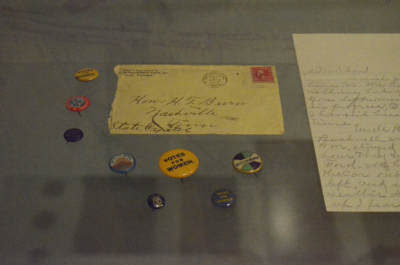 “We hold these truths to be self-evident, that all men are created equal…”
“We hold these truths to be self-evident, that all men are created equal…”
It is with these words that the Declaration of Independence sparked a revolution. Seventy-two years later, Elizabeth Cady Stanton evoked this same phrase, altered slightly to include “and women,” to ignite a movement that would span the better part of a century. This march to victory began in kitchens and parlors, but it would end in the Tennessee State Capitol Building.
While the push for the ratification of the 19th Amendment was propelled by suffragists across the nation, Tennessee was the last battleground in the fight for woman suffrage. The East Tennessee History Center’s new feature exhibition, Marching to Victory: East Tennessee’s Role in Votes for Women, highlights Tennessee’s path to becoming the “Perfect 36” – the final state needed to ratify the 19th Amendment to the U.S. Constitution. With the centennial of the ratification of the “Susan B. Anthony amendment” taking place this year, Marching to Victory is the perfect opportunity for visitors to show their true (yellow, white, and purple) colors and celebrate such a historic event. Visitors will be transported back in time as they walk through the exhibition set in a 1920s East Tennessee Streetscape that features “suffragists” protesting and flyers for suffrage lectures posted in windows.
As any fan of the musical Hamilton knows, Angelica Schuyler promised to compel Thomas Jefferson “to include women in the sequel.” While these words may not have been spoken by the real Angelica, American women have been fighting for equality since the country’s founding. In 1776, Abigail Adams, future First Lady and wife of John, pleaded for her husband to “remember the ladies” and warned of “a rebellion” should they not be represented in this new country.
Marching to Victory: East Tennessee’s Role in Votes for Women discusses not only Abigail Adam’s early advocacy for women but also that of the women who came after. Many of the founders of the Women’s Rights Movement were ardent abolitionists who supported the ratification of the 13th Amendment, making slavery illegal. When, in turn, the 15th Amendment gave only Black men the right to vote, suffragists turned their disappointment into momentum and forged ahead. The intersectionality of race and gender in the movement is a focus of Marching to Victory, allowing the exhibition to include diverse stories of Knoxville women, like that of Cora E. Burke, a Black teacher who started a local political league and later served as an election official. And for more information about the struggles that Black Tennesseans faced at the polls, visitors can then visit the feature gallery to view Black & White: Knoxville in the Jim Crow Era.
Throughout the Marching to Victory exhibition are flags spotlighting East Tennessee’s involvement in woman suffrage, with the stories of Elizabeth Crozier French, the first woman to deliver a public address on Knoxville’s Gay Street; Mary Wilson McTeer, President of Tennessee’s second suffrage club, founded in Maryville; and Eliza Shaut White, a member of the Equal Suffrage League of Johnson City. These women have unique stories that led to their own participation in the woman suffrage movement, but they are also representative of the numerous suffragists that spanned the region.
 The decades of hard work and determination of Tennessee suffragists, and those across the nation, came to a head in Nashville in 1920. In a special session of the Tennessee legislature, Representative Harry Burn of McMinn County, cast an unexpected vote in favor of the ratification of the 19th Amendment and sent shockwaves through the nation. Prior to the vote, Burn had received a letter from his mother, Febb Ensminger Burn, telling him to “be a good boy and help Mrs. ‘Thomas Catt’ [a well-known suffragist] with her ‘Rats’ [ratification].” With this letter in his pocket, Burn voted “aye” and paved the way for the 19th Amendment to officially become part of the U.S. Constitution on August 26th, 1920.
The decades of hard work and determination of Tennessee suffragists, and those across the nation, came to a head in Nashville in 1920. In a special session of the Tennessee legislature, Representative Harry Burn of McMinn County, cast an unexpected vote in favor of the ratification of the 19th Amendment and sent shockwaves through the nation. Prior to the vote, Burn had received a letter from his mother, Febb Ensminger Burn, telling him to “be a good boy and help Mrs. ‘Thomas Catt’ [a well-known suffragist] with her ‘Rats’ [ratification].” With this letter in his pocket, Burn voted “aye” and paved the way for the 19th Amendment to officially become part of the U.S. Constitution on August 26th, 1920.
In Marching for Victory, visitors can view Febb Burn’s legendary letter as well as other artifacts from the suffrage movement. Guests from around the world can experience the “march to victory” in the state where the final push for the 19th Amendment took place and the region where Rep. Harry Burn and Febb, Burn, his mother, resided.
Visitors are welcome to stop by the East Tennessee History Center (601 South Gay Street) to see Marching to Victory (on view through November 2020) Monday through Friday from 9:00 a.m. to 3:00 p.m., Saturday from 10:00 a.m. to 3:00 p.m., or Sunday from 1:00 p.m. to 4:00 p.m. Please observe current guidelines while inside our building. Visitors should also keep an eye out for statues celebrating women’s suffrage around downtown Knoxville – like the one behind the East Tennessee History Center on Market St. and the one on Market Square.
For more about Marching to Victory: East Tennessee’s Role in Votes for Women and upcoming events, please visit www.easttnhistory.org and be sure to follow @eastTNhistory on Facebook, Twitter, Instagram, and TikTok!

